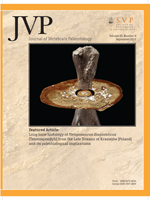This paper describes a new species of the genus Adocus (A. inexpectatus, sp. nov.), based on an almost complete shell from the upper Eocene Youganwo (= Youkanwo) Formation of the Maoming Basin, China. The inclusion of A. inexpectatus in a phylogenetic analysis of Adocusia resulted in a polytomy with Adocus aksary and A. amtgai (both from the Upper Cretaceous of Asia). This clade formed a polytomy with the North American species of Adocus. Like other ‘true’ Adocus, A. inexpectatus has overlapping of the marginals onto the costals in the middle and posterior parts of the carapace and sculpturing of the shell surface with small grooves and pits. Thus, A. inexpectatus represents the first ‘true’ Adocus from the Paleogene of Asia. Other specimens from the Paleogene of Asia that have been referred to Adocus, characterized by shell sculpturing with small dots and unknown condition of the marginal/costal overlapping, are distinct from ‘true’ Adocus and herein referred to as ‘Adocus’ spp. Here we also report the presence of ‘Adocus’ from the Paleocene of North America. Our study indicates that the evolutionary and biogeographic history of the Adocidae was more complicated than considered previously, including previously unrecognized dispersal events between Asia and North America.
SUPPLEMENTAL DATA—Supplemental materials are available for this article for free at www.tandfonline.com/UJVP





